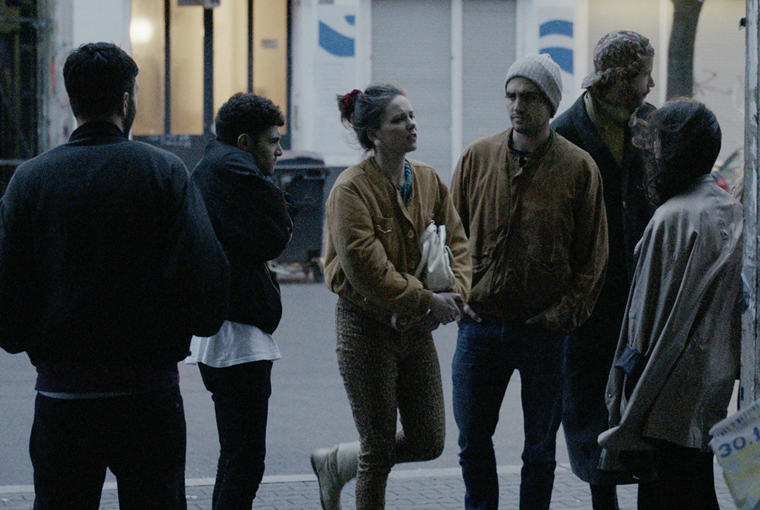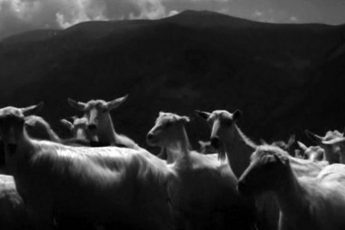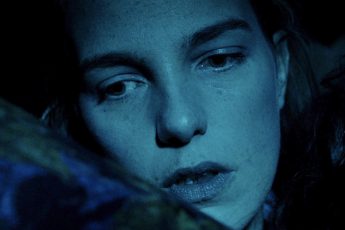
We met up with Simona Kostova, a Bulgarian filmmaker, and Ceylan Ataman-Checa, her German producer, the morning after the World Premiere of their debut feature “Thirty” at the International Film Festival Rotterdam 2019. Kostova and Ataman-Checa are a young Berlin-based director-producer team, who met and trained at the German Film and Television Academy Berlin (DFFB). They talk about their working relationship, DIY ethos and the challenges of making a debut feature for 5,000 Euros.
Simona you’re a Bulgarian filmmaker who has trained in Germany. This is your first feature film. Had you done anything beforehand?
Kostova: Yes, I had done many small films at the film school, but these were just exercises to help me learn a little about what cinema is and stuff like that.
This is a big leap into the first feature film then. How long was it after your training at DFFB until you made Thirty?
Kostova: I didn’t finish. This isn’t a graduation film. This took a bit longer, so it is just a film and not a graduation film. It is a very cheap movie. We shot it in eight days. It wasn’t really possible any other way.
How did you come together as a producer-director team?
Kostova: Ceylan is also a director. I couldn’t find a producer for the movie. It was difficult and we were shooting in eight days. Then there was the issue of the script. After rehearsals it worked, but when people were just reading it, they didn’t get it, which made things a bit tricky. Ceylan and I had always worked together as two directors helping one another. That was what made me ask him if he would produce the movie.
Ataman-Checa: She had been rehearsing already for one year before the actual shooting. We got tons of Hi-8 material, because I used to film a lot on Hi-8. I like material things that are always available. Also, Hi-8 shoots 4:3, which was always going to be our format. I can remember in 2015 when we told people we were shooting a feature in 4:3 aspect ratio, they immediately asked us, ‘why?’. Then spending three years in post-production, suddenly every third Hollywood film was in 4:3. The main thing that brought us together was a desire to experiment with the form and the material, instead of selling the film before it is even made – something we have always been really bad at.
Kostova: You can’t just make a movie for a festival. You have to be ready for a festival. It can be very dangerous if you are not ready, even if you have some success.
Ataman-Checa: Simona didn’t really have a script in written form because she was still working out what exactly would happen during this night at the center of the film. By comparison the day part of the film was always scripted, from the very beginning. So, without a complete script it was very hard to convince even students to be involved with the shoot, especially as we couldn’t say how long the film would be in the end. Also, we only had 5,000 Euros to produce the movie. So many producers were like immediately ‘No!’. Nothing seemed concrete enough for them. But I knew Simona and what she wanted.
What crew size was involved in the making of the film? Did you have a DOP and sound recordist? I’m guessing with your budget the DOP was likely a first-timer.
Kostova: It was a small, tight unit. I edited the film and also developed the sound design. When you edit you are doing so much on your own. You just cannot pay people. The film had a very poor soundtrack, because if you shoot like we did then the boy with the microphone is always left behind. You know what I mean. It looks very funny. Our DOP was one of the cameramen from the school. He had been an actor before he was a DOP. I liked him from the very beginning and love working with him. He is a crazy guy who will do anything you want and is always building stuff to help get shots you thought you couldn’t. Where you needed a dolly, he would find a way to do it without.
There were definitely a number of points in the film where I wondered how you were doing things. After a while I actually began to think you were even challenging the audience to answer how exactly you were doing these things. In particular there is a shot where you follow the cast running through the streets. At the end of this shot, the camera turns back to look at where they have just run from, and you see a heap of rubble with the actors’ footprints coming through the center of it, but no obvious signs of how the DOP has come across it. This really did feel like rather raw, virtuoso camera stunts on a shoestring.
Ataman-Checa: There are a lot of funny stories about the shoot. Simona wanted to have a dolly, but the streets of Neukölln are very tricky. She wanted to have a track running directly from the apartment to the Herz Bar. So these two locations needed to be on the same street, as Simona wanted these spaces to connect in the edit.
Kostova: I wanted them to seem real. This is the bar and you know exactly where it is.
Ataman-Checa: So, Simona wanted the cast to run on the street for a specific length of time. I then had to measure the distance from the Herz Bar to the next bar on the street. But there was no other bar on the street at that time. However, there was a place that had been a bar before, but now was a refurbished pizza place. Simona and Anselm [the DOP] had fallen in love with a certain type of old dolly, so we then constructed a bar inside of this pizza place. Then in the edit Simona decided to leave out all of the footage that was the journey from one bar to the next.
Kostova: It was very important to have the sense of a tight womb, in which the cast were hidden, for as long as possible. We found it in that pizza place, which was amazing. We had forty people in it, which was still not enough. But that bar had a front and a back entrance, so all the extras – I hate calling them that because they are actors really and great people – but they were just running the whole time through the bar. This was really exciting.
Ataman-Checa: To actually get the extras we took each of them to a flea market to find suitable vintage garments for their roles. It is so tough to get extras. If you don’t offer something, then you aren’t going to get them. It’s a classic thing, which is why party scenes in student movies are always empty. You may have a lot of friends, and they all want to come, but you’re shooting on Tuesday at 10am, when nobody can be there.
How did you go about getting together that group of six people, who clearly have a great rapport? You believe that they are friends. You believe that they have a stronger connection.
Kostova: I don’t write the script at home and then start looking for the actors. I need them from the beginning, and then rehearse with them a lot. Pascal I knew from one of Ceylan’s early films, he is a TV actor. Kara was also in student productions. Everybody else is a good friend of myself or Ceylan.
Ataman-Checa: Henner is actually my best male friend and Raha my best female friend, although she was never supposed to play in the film. There was a small issue with the timetable of the film, and the person originally down to play the role of Raha had a contract for something else, so we had to move on. It was a shame as she was an actress we really, really like. We still want to support her though. Then Raha came along to one of our workshops.
Kostova: She crashed in.
Ataman-Checa: In fact this is what we like to do. We like to do workshops, as Simona’s thing is all about getting people in to get ideas. Then improvisation can get things to a certain level where we already have something.
Kostova: One of the workshops was focused on how to make a film about being thirty. That’s a really abstract thing, when you think about it. I posted on Facebook asking for people to talk about their experiences. Loads of people came on board at this point and we got some really heart-breaking stuff, which convinced me that we could make a film about this, based in Berlin.
How much of your final script came directly out of those rehearsals?
Kostova: We were rehearsing whatever came to my mind, then we worked these ideas up together and then I would sit down and write a script from this. Kind of mixing what we made with an edited written version.
There is a scene early in the film involving the opportune use of a blender that convinced me that I was in good hands. Also, looking back on the first scene, your character Ove manages to never once enter the center of the frame until right at the end of the scene when he opens and closes a window. He is a character moving around the periphery of the shot. A literal peripheral figure. I wanted to know a bit more about how you modulate humor and horror through the use of what lies at the edge of the shot or beyond the frame? How did you develop this visual language?
Kostova: It was pretty intuitive. I don’t really think about this until I can see the pictures. Afterwards, when I edit the movie I know why it is there, but it would be a lie to say I made it like that. The opening scene, however, was a very important one for me. It took me a lot of time. There is an intense feeling in it. This had to tell everything about the movie, so I am very happy that you are picking up on these ideas of the periphery and the center.
What about your use of locations in Neukölln? Where did you source them and how were you working with production design?
Ataman-Checa: We used our apartment in the area, Ove’s flat is his own. However, we did redecorate and we made that bed. It’s important to say here that Simona and I are kind of control freaks, so we tend to do things on our own. The bed we did on our own. We sent Ove out of his flat and then just renovated it ourselves. This is something maybe in the future we need to learn to give away, but somehow we think this is too hard, as this is the process. When Simona was making the floor, she was entirely getting into other elements of the film through that process.
Kostova: Yes, but it depends. People always tell you there is not enough money to do something. I would love to work with people who make stuff. But without money, I am sick of hearing it can’t be done. Even without money I am just going to do it. Then you will see it is possible.
Ataman-Checa: I think that Simona isn’t like the typical director. She doesn’t do storyboards, she doesn’t have the shot programmed before, and also Anselm [the DOP] isn’t the classical cameraman. Anselm is one of the people who is convinced by Simona completely and trusts her completely. I think this is the big plus of the movie, Simona needs to only explain something to Anselm, and he sees it, then they almost move together – Simona maybe moving Anselm, just a little.
How did your professional relationship develop on the shoot? Were you happy to be working with a familiar face, someone you already understood?
Ataman-Checa: Kostova: It was more about having someone creative on your side, to reflect off of. I can say on Thirty a lot of small elements of Simona’s work came together. That is why having your creative partner on set helps, as you get an immediate sense of what you are doing well and what doesn’t work. Everyone on film knew the connection that we had and didn’t disrupt our flow when we were chatting.
Kostova: It was also important to find someone who is not asking so much, ‘why?’. Some cinema directors know exactly why they do what they do. But I mainly see things in the edit. I am making the movie to understand why.
This sounds like an interesting process of shooting almost instinctively, and then putting a shape on things in the post?
Kostova: Yes, in editing you realize very much why you have chosen one thing or another. I am practiced. I trained at school, so it isn’t that I don’t know what I’m doing. It’s just you edit things as you write them, seeing things as if for the first time.
Ataman-Checa: I also believe that what an audience feels with this film is rhythm, complete rhythm. It took almost a year-and-a-half for Simona to edit. On several occasions we had what felt like a complete film, then Simona would find something very small, and find a new rhythm.
Kostova: The editing of this movie is not like putting together something with lots of little cuts. It is more about a question of time. You shift one minute in the film and suddenly the edit doesn’t work. So, this was a learning process for me.
Thank You for the interview.




Leave a Comment